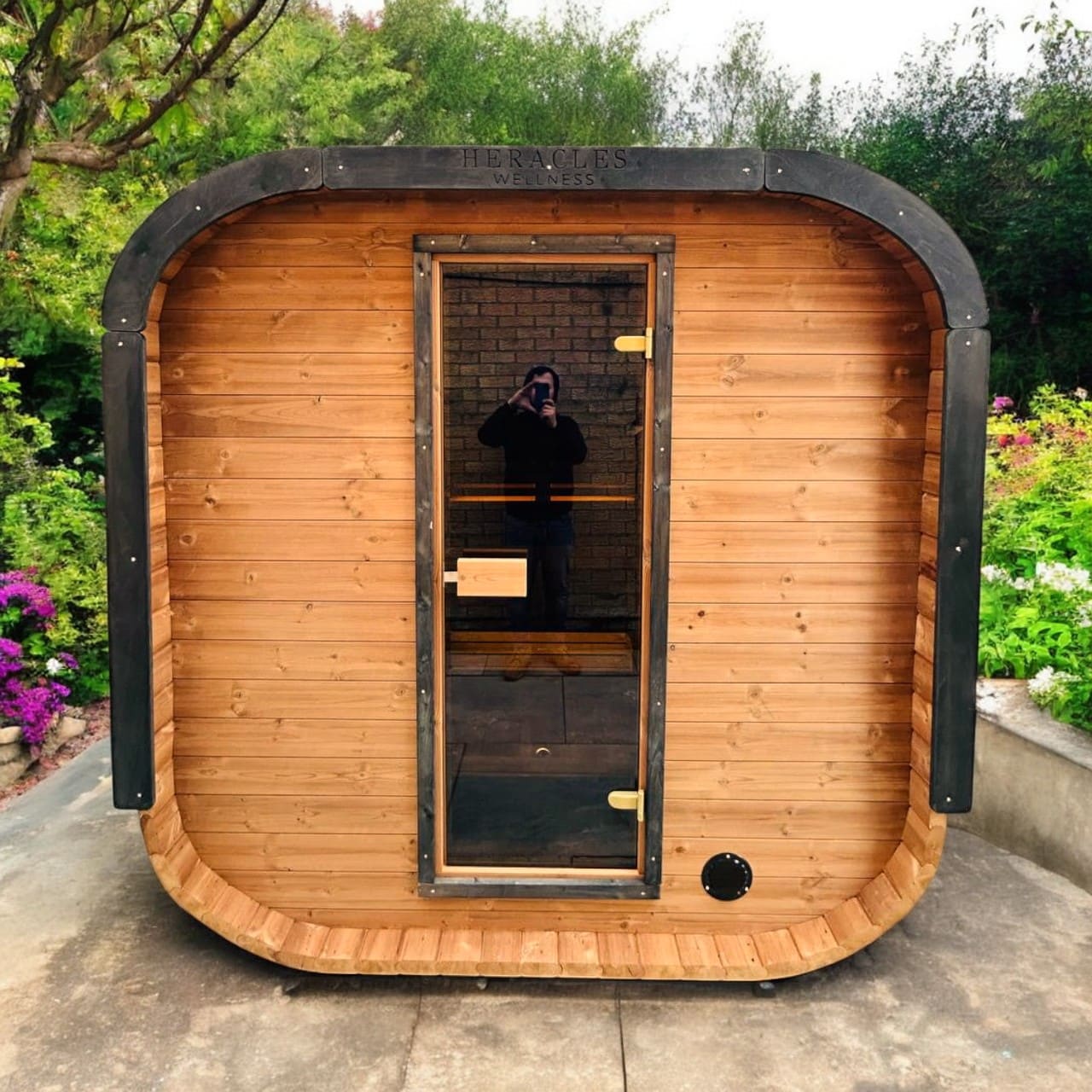We've established that we're fans of Infrared Saunas at Hercales Wellness, you can read all about their benefits here and here. But How much do they cost to run?
The cost of running an infrared sauna mainly depends on factors such as size, wattage, usage frequency, and electricity rates in your area. Generally, infrared saunas are energy efficient and have lower operating costs compared to traditional saunas. To estimate the electricity usage of your home sauna, you can calculate the kilowatt-hours (kWh) by multiplying the sauna's wattage by the number of hours used and then divide by 1,000.
Key Takeaways
- Infrared saunas offer health benefits and are easy to install at home.
- Running costs depend on factors like size, wattage, usage, and electricity rates.
- Comparing various cost factors helps in making an informed decision when choosing a sauna for home use.
- If you have a 1.6kWh IR sauna and use it for an hour a day, it will cost you £12.96 a month.
How Much Does It Cost to Run an Infrared Sauna?
Electricity Costs and Usage for Infrared Saunas
Running an infrared sauna can be quite energy-efficient, as most models consume between 1.2 and 2.4 kilowatt-hours (kWh) of electricity per hour. To calculate the cost of running your infrared sauna, you simply need to multiply that usage by your local electricity rate. For example, if you have a sauna with a 2kWh heater and an electricity rate of £0.15 per kWh, running it for one hour would cost £0.30 (2kWh x £0.15).
Comparing Running Costs of Infrared Saunas
There are various types of saunas, such as traditional steam saunas and infrared saunas. Traditional saunas require more energy to heat the air and are generally more expensive to run. In contrast, infrared home saunas use far less energy and can be more cost-effective. According to this study, a nine kW infrared sauna requires approximately 10,800kWh per year, making infrared saunas more energy-efficient.
Factors Affecting the Cost of Running an Infrared Sauna
-
Size: Larger saunas typically need more energy to heat, resulting in increased running cost.
-
Frequency: How often you use your sauna will directly affect the overall operating expense.
-
Insulation: Properly insulated saunas retain heat better, reducing energy consumption.
-
Temperature: Running the sauna at a higher temperature requires more energy, and thus increases the cost.
-
Local energy rates: The cost of electricity in your area will impact the total cost of running your sauna.
Choosing the Right Infrared Sauna Model to Minimise Costs
Select a sauna model that meets your needs and considers energy efficiency. Look for models with low kWh heater ratings and additional energy-saving features. Review the manufacturer's specifications to confirm the energy usage and compare running costs between different sauna models, ensuring you make an informed decision.
Maximising Efficiency: Tips for Reducing Electricity Usage
-
Preheat: Limit preheat time or even skip preheating if the sauna reaches an adequate temperature quickly.
-
Maintain: Keep your infrared sauna clean and well-maintained to ensure optimal performance.
-
Use a timer: Set a timer for your sauna sessions to prevent overuse and unnecessary energy consumption.
-
Insulation: Evaluate the insulation of both the sauna itself and the external environment to minimise heat loss.
Differences in Cost between Infrared and Traditional Saunas
Comparing Electricity Usage of Infrared and Traditional Saunas
Infrared saunas tend to consume less electricity than traditional steam saunas, making them more cost-effective. On average, infrared saunas operate at around 1.5 kilowatts (kW) per hour, while conventional saunas use approximately 6 kW per hour.
Understanding the Impact of Heater Types on Running Costs
Heater types can significantly impact the cost of running your sauna. Infrared saunas primarily use carbon heaters, which heat up quickly and distribute heat more evenly. Traditional saunas require a heating element to warm up the rocks, consuming more energy in the process.
Calculating the Average Cost of Running Different Types of Saunas
To estimate the average cost of running a sauna, consider the electricity rate (per kilowatt-hour) in your area and multiply it by the sauna's electricity usage. For example, the current cost of a kWh in the UK is 27.35 pence:
- Running your infrared sauna (1.5 kW) for an hour: £0.2735 x 1.5 = £0.41
- Running your traditional steam sauna (6 kW) for an hour: £0.2735 x 6 = £1.64
As seen, the infrared sauna is four times cheaper than traditional in this example.
Cost-Effective Home Sauna Solutions: Infrared vs. Traditional
Given their lower electricity usage, infrared saunas are generally considered more cost-effective than traditional steam saunas. Additionally, infrared saunas require less maintenance and usually have faster heat-up times, adding to the cost savings.
Factors Influencing the Cost to Run a Traditional Sauna
Not all traditional saunas have the same running costs. The size, insulation, and heating elements all influence the cost. Generally, the larger the sauna, the higher the energy consumption. Smaller saunas require less energy to heat and, thus, may be more economical. Keep in mind, however, that infrared saunas are still more energy-efficient overall.
Estimating the Electricity Usage of a Home Sauna
Factors Affecting Electricity Consumption in Home Saunas
Several factors can affect your sauna's electricity consumption:
- Size and type: Larger and more powerful saunas consume more electricity.
- Insulation: Well-insulated saunas retain heat better, reducing energy consumption.
- Usage: The more you use your sauna, the higher the electricity costs will be.
- Temperature settings: Higher temperatures require more energy to maintain.
Maximising Efficiency: Tips for Lowering Home Sauna Electricity Usage
To reduce the electricity usage of your home sauna:
- Preheat: Allow the sauna to reach your desired temperature before entering.
- Insulate: Ensure the sauna is well-insulated to minimise heat loss.
- Optimise temperature: Find a comfortable temperature that isn't excessively high.
- Limit usage: Use the sauna for shorter periods to lower energy consumption.
Electricity Costs for Different Sizes and Types of Infrared Saunas
The cost of running your home sauna will depend on factors such as sauna size and type. Generally, a 2-person infrared sauna will consume around 1.6 kWh, while a 3-person infrared sauna might use about 2.4 kWh. To estimate running costs, multiply the electricity consumption by your local electricity rate per kWh.
Comparing Energy Efficiency of Different Infrared Sauna Models
When choosing a sauna, consider energy efficiency. Compare not only the power ratings of different models but also the insulation and heating technology. An efficient infrared sauna can help you save both energy and money in the long run.
Remember, selecting a sauna that suits your needs and optimising its use can help reduce your electricity costs.
Choosing a Sauna for Home Use: Cost Factors to Consider
Understanding the Impact of Sauna Type on Electricity Costs
When selecting a home sauna, it's important to consider how different types affect electricity consumption. Traditional saunas use more energy, whereas infrared saunas are known for their energy efficiency. In general, infrared saunas consume about 1.6 kWh of electricity per hour, whereas a traditional sauna may use 6 kWh or more. Make sure to take these costs into account when choosing your sauna.
Evaluating the Total Cost of Running a Home Sauna
The total cost of running your infrared sauna at home depends on factors such as:
- Electricity cost per unit
- Daily or weekly usage frequency
- Sauna size and temperature settings
For example, if you pay £0.27 per kWh and use your 1.6 kWh infrared sauna for 1 hour daily, your monthly energy cost would be approximately £12.96. Remember to factor in additional costs like purchasing and installing the sauna, maintenance, and any additional accessories.
Comparing Electricity Usage of Infrared Saunas at Home vs. in Gyms or Spas
Infrared saunas are often cheaper to run at home, thanks to their energy efficiency. A gym or spa might charge a premium for their facilities, which means that the cost of electricity is only a part of the total expense you'd incur. In addition, having a home sauna enables you to tailor your sauna experience to your personal preferences, making it a more enjoyable and cost-effective investment.
Optimising Home Sauna Efficiency to Minimise Electricity Costs
To reduce energy costs, consider the following tips for optimising your home sauna's efficiency:
- Inspect your sauna's insulation and ensure a tight seal when not in use
- Turn off your sauna when not in use instead of leaving it on standby mode
- Use energy-efficient bulbs like LED lights for interior lighting
- Set the appropriate temperature for your sessions (about 43-66°C (110-150°F) for infrared saunas)
- Consider scheduling sessions during off-peak electricity hours, if possible
Financial Considerations: Is It Cheaper to Run a Home Sauna or Use Sauna Facilities?
When comparing the convenience and cost of an infrared sauna at home to that of visiting a gym or spa, it's essential to weigh up the benefits and drawbacks of each option. Potential benefits of an infrared sauna include detoxification, relaxation, and overall wellness. Ultimately, the choice will come down to your personal priorities, budget, and lifestyle.
Q: What is an infrared sauna?
A: An infrared sauna uses infrared heat to directly warm the body, unlike traditional saunas which heat the air around you.
Q: How much electricity does an infrared sauna use?
A: Depending on the size and usage, an infrared sauna typically uses less power compared to traditional steam saunas. A 3-person infrared sauna may cost around £4-5 per month when used for an hour a day.
Q: Are infrared saunas cost-effective in terms of energy use?
A: Yes, infrared saunas have lower energy consumption compared to steam saunas, making them more cost-effective in the long run.
Q: What factors can impact the electricity cost of running an infrared sauna?
A: The size of the sauna, the frequency of use, and the desired temperature can impact the electricity cost of running an infrared sauna.
Q: How can I estimate the cost of running an infrared sauna at home?
A: You can estimate the cost by checking your electricity rate and calculating the energy consumption based on the sauna's power usage and duration of use.
Q: What are the benefits of using an infrared sauna with lower electricity consumption?
A: Lower power usage not only saves on electricity costs but also reduces your environmental impact while still providing the benefits of infrared sauna therapy.
Q: Can I enhance my sauna experience without significantly increasing electricity usage?
A: Yes, you can enhance your sauna experience with features like chromotherapy lighting and premium wood materials without significantly impacting electricity usage.
Q: What types of wood are commonly used in building infrared saunas?
A: Canadian Hemlock and Red Cedar are popular choices for building infrared saunas due to their durability and resistance to heat and moisture.
Q: How does the infrared sauna's electricity usage compare to a steam sauna?
A: Infrared saunas use less power compared to steam saunas, making them a more energy-efficient option for indoor sauna use.
Q: Do infrared saunas use less power than traditional steam saunas?
A: Yes, infrared saunas use less power, making them a more efficient and cost-effective option for those looking to enjoy the benefits of sauna therapy at home.















Leave a comment